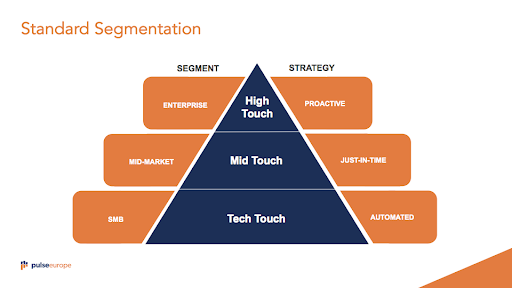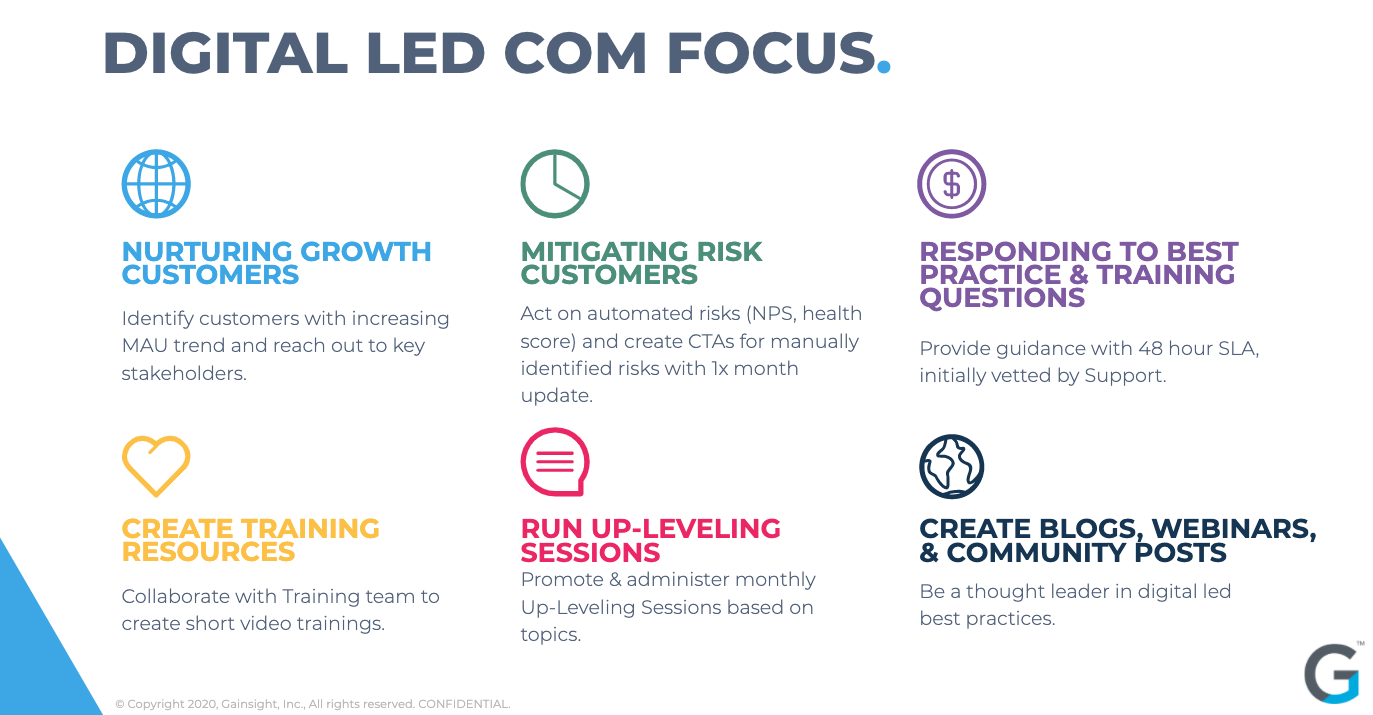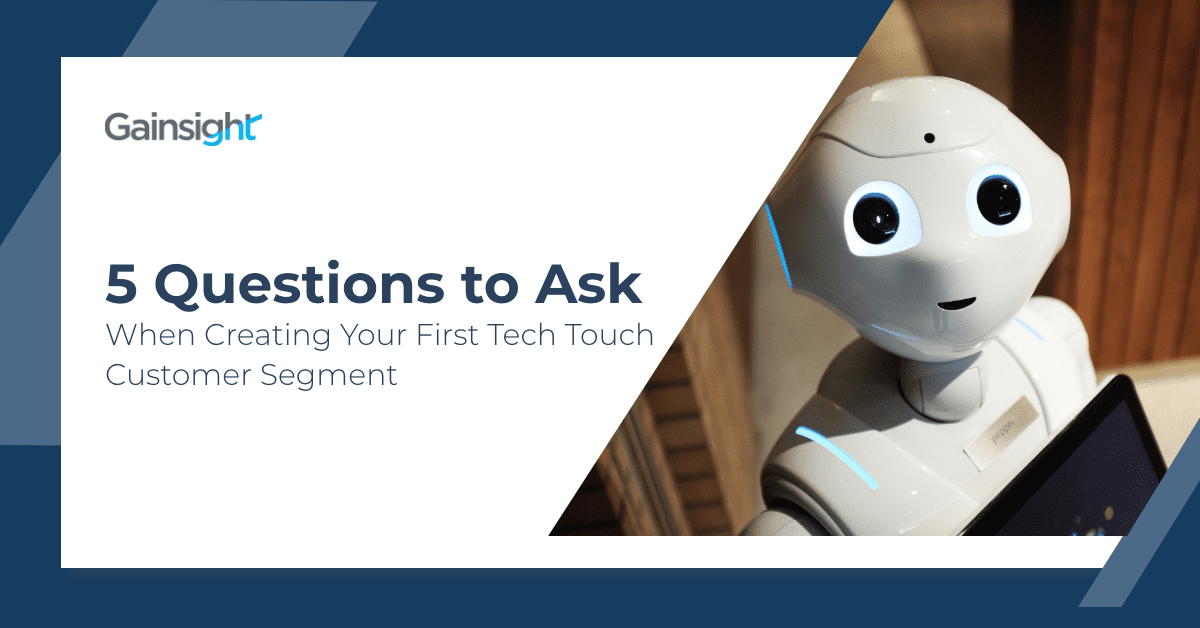It is not uncommon for companies to transition customers to varying segments, especially during an economic downturn. The expectation to do more with less has companies reallocating and stretching internal resources. They also want to protect their customer base by placing a renewed and focused emphasis on particular segments within the base. That means improving or increasing their customer success managers (CSM) ratios for their top Annual Recurring Revenue (ARR) customers, especially those at an enterprise level.

When companies examine re-segmentation, there is a set of customers that seem not to garner attention. When these customers are removed from a higher segment and placed in the “tech touch” or “low touch” level, it is tempting to overlook them. However, they shouldn’t be so easily ignored because they can be highly profitable in aggregate. When combined, their total volume, or “long-tail,” can amount to significant revenues.
In the SaaS industry, they might not have the visibility of enterprise clients, but they also don’t have the demands that can erode your profits. You may find that tech touch or low touch customers have the combined ability to be more profitable than expected in the long term. They also have staying power if appropriately managed. The key phrase is “managed properly.”
Managing New Tech-Touch Customers
Companies must remember that the customer needs to feel valued while obtaining value from your product as they begin transitioning customers. The balance is retaining a Human-First tone when using technology to message out to your tech touch segment. How do you utilize tech-touch to manage customers, and what does this mean for those customers placed into new segments? Here are five essential questions to answer for yourself and your customers when transitioning to tech touch.
1. What is the “Tech-touch” customer lifecycle? And how will you accomplish it at scale?
You want to maintain a similar level of value delivered to the customer, but at a greater scale. To do this, you have to identify areas that can be automated and amplify the CSM capabilities that can be done only by a human, making even those tasks more efficient.
Next, take the time to identify your ideal lifecycle for Tech-touch customers. Your engagement with your customers will be driven by one of three things:
- Pre-planned and proactive engagements: Quarterly Business Reviews
- Ad-hoc, proactive engagements: Impromptu calls/emails to customers or data-driven outreach
- Reactive engagements: Customer issues that require immediate attention
Now figure out how to hit those milestones, including the planned or unplanned issue at scale. We are using the Gainsight PX and CS platforms for our tech-touch segment to enable the lifecycle. For EBRs, we are no longer meeting in person or over a call, but we are using Gainsight CS Email Assist to templatize most of the email, but still allow our team members to customize their outreach based on the use case. Remember, this is not about reducing the value delivered to your customer. It’s about becoming more efficient.
Some initial key learnings with the EBR email function are to include information on analytics, specific suggestions for their use case, an ask for a public review, the list of all other use cases, and a question of what may be interesting for their growth. We also use the Zendesk and Gainsight CS integration to bring best practice requests into CS as a call to action or CTAs. We continue to use PX in-app surveys for NPS and to collect input on ROI accomplished. Ultimately, your goal for these customers is to deliver expected outcomes while creating an exceptional experience.
2. Who will support this segment? What should their title be? What should they be responsible for?
First, what to call the “CSM” of this segment is dependent upon your company. But consider this, will they have the same objectives, responsibilities, and compensation? Yes, they do; however, they operate digitally. The Tech-touch CSM is a rare beast that understands the nuances of digital relationships and automated engagements. Give them credit for that because they may have a sense of patience that other CSMs do not have.
When you have a large segment of automated tech-touch clients, it is necessary to realize that the CSM role doesn’t disappear. The CSM’s objective becomes more significant. In the Tech Touch segment, you utilize automation and digital engagements, isolating some customers. Yet, you are leveraging the process to get scale. Often, one person is overseeing hundreds of accounts. That is where Tech-touch strategies come into play.
It can be economically challenging to serve tech-touch customers by staffing CSMs in this segment, even in businesses with high margins. What often happens is that the CSM becomes overworked or spends too much time on repetitive activities. What you will need is a Tech Touch strategy to complement your CSMs. The strategy is to surface risks and expansion opportunities across a large segment of customers. The ultimate goal is to prioritize human intervention only for the most critical situations.
Since proactively managing customer risks is the core of every CSM job, the platform your business utilizes should enable the CSM to perform that duty. In the Tech-touch segment, the small-sized customers who are often subscription-based can churn at a moment’s notice. But small Tech-Touch customers are necessary and are critical to scaling for most companies. So, how do you balance the risk?
Ultimately, you must consider the number of customers you expect to fall into the segment. Begin with a few customers. This allows your team to be proactive with customers in a scalable manner. Next, realize that someone will always need to monitor the program and the systems running it. If you are still thinking about what a title for this position should be, consider something like “Program Manager.” Their role will encompass little to no live customer interaction except through the manner mentioned earlier. This position must also iterate on aspects of the life cycle, communication, and general scalability. At Gainsight, we have team members available for best practice questions and to own the segment, the iterating, and monitoring aspects.
3. Will there be an option for customers to reach out to a real person or full tech touch?
YES! But it may depend if your company has a tiered paid CSM offering. Reassure your customer that somewhere there is a human that they can reach out too. However, they must be reminded that tech-touch customers are traditionally engaged via email, in-app message, or other automated outreach.
No matter where the customer sits in a segmentation model within your install base, you want to ensure that they have effective communication, the right prioritization, and success with your product. The best way to do this is to inform the customer that part of the transformation is amazing new resources that enable them to help themselves 24 hours a day, seven days a week.
Upfront, you’ll need to decide if customers in this segment communicate with your company through automated means (e.g., in-app NPS, Community, Office Hours, Webinar), or if there will be an option to speak with someone live about best practices and strategy questions.
This impacts the cost to run this segment of customers and the experience these customers will have. At Gainsight, we give the customers the option to contact a team member and recommend starting with this model for a “crawl” approach. This decision affects how you give customers access to their entire set of resources, and what you do as far as title and responsibilities for team members owning the segment.
The other part of this issue is that customers want to know that they are heard. Listening to the customer should be embedded in your CS platform and capture data and perspectives on its experience. In PX, you can raise your tech touch customer’s visibility, capture the voice, and act in real-time. That also includes a necessary closed-loop response and action plan. By raising the visibility of the customer, you can analyze the progress against customer experience.
4. Do you have the right resources ready to enable these customers?
“CEOs choose their retention rate.” This is the answer given by Dan Steinman, Gainsight’s first CCO, former Head of EMEA and foremost CS evangelist when speaking about building a CS practice. The statement is most appropriate here. In other words, how many resources you assign and what automation tools are available to manage the tech touch segment will have a direct correlation to the retention rate.
It’s also essential to prioritize tech-touch activities that can be done at scale. They may be one-to-many customer meetings or webinars covering product adoption and best practices. There are also blanket contact campaigns of monthly or quarterly e-newsletters, data triggered email campaigns, on-demand training and guidance, and access to a community portal.
In addition to all of the resources mentioned above, consider creating a wiki or in-app center for customers to access digital assistance. You could also recommend breaking the resources down a few ways, such as Executive and System-level so that the customer contacts can get what they need.
5. Will customers be allowed to upgrade services in this segment?
This question may come up for existing customers that are transitioning to this segment and for new customers. Truthfully, it is a company preference. You’ll need to decide if customers can upgrade services out of the non-tech touch segment. If yes, is it recurring revenue or a one-time fee?

When implemented and managed correctly, tech-touch strategies not only work well, but they can become lucrative. However, the strategy should aim to manage tech-touch customers across their lifecycle through efficient automation, while only using a single or a small group of CSMs for many customers. There are essential aspects to a successful tech touch strategy—detecting risks and exposing expansion opportunities across the segment. This can be challenging if the tech-touch segment is substantial. With the right resources and CS platform, your company can master this motion. More importantly, you will be able to protect your customer base during times of economic stress and uncertainty. This is one of the highest priorities for any subscription business. Take a tour of Gainsight to see how using our Customer Success platform can make creating a tech-touch segment simple.

